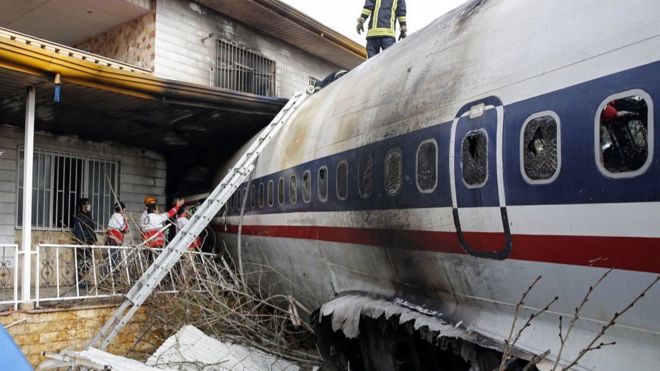January 25, 2019

An Iranian Air Force Boeing 707 landed on a short runway, shot passed the end of the tarmac and into an adjoining residential area, killing 15 of the 16 aboard, but not even injuring anyone on the ground.
Many news accounts sought to blame the fatal crash on the United States for refusing to sell Iran spare parts for American-made aircraft. But the fact was that the crew failed to see the airport where they were supposed to land and instead came down at a small airfield whose short runway was barely half the length required for a 707.
The plane was a cargo aircraft flying from Kyrgyzstan, where it had picked a load of animal carcasses to be taken to Iran to feed military personnel. Along the way, the pilot radioed that he had an in-flight emergency and needed to land quickly. It has not yet been reported what the emergency was.
The crash occurred January 14 in Karaj, where the plane was cleared to land at Payam International Airport. But instead the pilot came down at Fath Airport, about 10 kilometers (6 miles) southwest of Payam.
The 707 needs 6,250 feet of runway in which to land. Payam has 11,800 feet, more than enough. But the runway at Fath is only 3,600 feet long. The crew didn’t stand a chance of stopping the plane in time.
Of the 16 on board, 15 died as the plane erupted in flames after crashing through a wall at the edge of the airport and coming to rest with its cockpit inside a home. The only survivor was the flight engineer.
The 707 was not the first jet used in commercial flights, but it was the first to make it big commercially and is credited with ushering in the jet age. It was made from 1958 to 1979. It has not been flown by any commercial airlines since 2013; Iran’s Saha was the last to fly it commercially. But it is still used by a half-dozen air forces.
Iran’s last major aircraft crash was just 11 months ago, when an Aseman Airlines ATR-72 flew into the side of a mountain as it was descending to land in Yasuj, killing all 65 aboard.
The Islamic Republic complained for decades that the United States had barred Boeing from selling it spare parts, saying that endangered Iranian passengers. That ban ended in January 2016 when the nuclear deal was signed and sanctions lifted. But restrictions on spare parts sales were re-imposed last August when President Trump put sanctions back in place. However, in the 2-1/2 years with no ban on parts sales, Iran bought only a solitary spare part from Boeing, indicating it wasn’t really impeded by the ban.
With almost 40 years of sanctions, Iran could never have kept any of its American planes flying without a continuous supply of spare parts. It is evident that Iran has made some backchannel deals to buy spare through foreign airlines that operate Boeings.


















